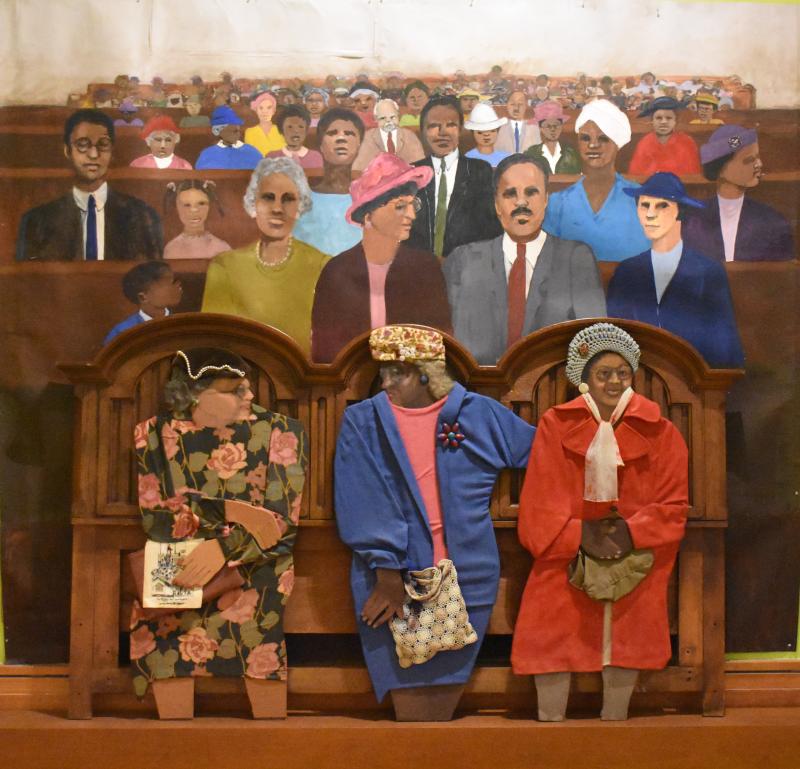Lift Every Eye and See: A Look at Art Works in HBCU Collections
As National Endowment for the Arts Chair Maria Rosario Jackson said in a recent video spotlighting Historically Black Colleges and Universities: “In communities across the United States, Historically Black Colleges and Universities are…serving as a reminder of and beacon for our rich culture.”
The museums and galleries housed on HBCU campuses play a vital role in that — they collect, preserve, contextualize, and display work by Black artists, providing students and the wider community with access to a range of work that shows the breadth and depth of artistic practices and perspectives across our nation’s history.
The history of HBCU museums and galleries themselves spans more than 100 years. Hampton University Museum was founded in 1868, making it the oldest African-American museum in the country. While relatively young in comparison, the Spelman College Museum of Fine Art, which first opened its doors in 1996, is equally groundbreaking. The museum collects art by and about women of the African diaspora, and it is the only museum in the United States with this explicit purpose.
These two museums and others shared pieces of their collections with us, providing a glimpse into impressive collections that, in the words of Chair Jackson, are both “a reminder of and beacon for our rich culture.”
Hampton University Museum

Augusta Savage (1892-1962). Lift Every Voice and Sing, 1928. Bronze. Dimensions 10 7/8" x 1/4" x 4 1/2". The Countee Cullen Art Collection. The Hampton University Museum Collection, Hampton, VA
Hampton University Museum is not only the oldest African-American museum in the country, it is one of the oldest museums in Virginia. The museum’s collection consists of more than 9,000 pieces, including African American, African, Native American, Asian, and Pacific Islander art and artifacts. Learn more.
Augusta Savage (1892-1962) was a Harlem Renaissance sculptor and art teacher. She was a graduate of the Cooper Union School of Art and the first Black member of the National Association of Women Painters and Sculptors. Lift Every Voice and Sing was inspired by the poem of the same name by James Weldon Johnson and represents the contributions of Black Americans to American music. Learn more.
James E. Lewis Museum of Art (JELMA), Morgan State University

Marie Johnson Calloway (1920-2018). Church Ladies, 1984. Mixed media on wood. Dimensions 85 x 85.5 inches. James E. Lewis Museum of Art, Morgan State University
JELMA was established at Morgan State in 1951 by James E. Lewis, an artist and professor. The museum was originally called the Gallery of Art at Morgan but was renamed in 1990 to honor Lewis, who also served as Chair of the university’s art department. Lewis believed in celebrating Black American artists alongside art and artists from other backgrounds, which is reflected in the museum's collection today. JELMA is located at the university's Carl Murphy Fine Arts Center in Baltimore. Learn more.
Marie Johnson Calloway (1920-2018) was a mixed-media artist from Baltimore. She attended Morgan State University, earning her degree in arts education in 1952. Notably, Calloway marched in Selma, Alabama, with Dr. Martin Luther King, Jr. in 1965. That experience was formative for her art, and she depicted scenes from the Civil Rights movement as well as other everyday moments from the lives of Black Americans in her work. She is known for her sculpted paintings — three-dimensional works that incorporated paint, wood, cloth, and other materials — like the one above from the JELMA collection. Learn more.
Spelman College Museum of Fine Art

Betty Blayton (1937-2016). Vibes Penetrated, 1983. Acrylic on canvas, diameter: 60 3/4 in. Spelman College Museum of Fine Art. Spelman College Purchase. © Estate of Betty Blayton
Spelman College Museum of Fine Art was founded at the insistence of arts faculty at the college, who championed access to visual art as necessary for a well-rounded education. The museum is located at Spelman College’s Academic Center in Atlanta. Learn more.
Betty Blayton (1937-2016) was an illustrator, painter, printmaker, and sculptor. She received a degree in painting and illustration from Syracuse University in 1959 and moved to New York City shortly after. In New York, Blayton co-founded and served as board secretary of the Studio Museum in Harlem and held numerous other positions in prominent Harlem arts organizations. She is known for her style of “spiritual abstraction,” in which she imparted moods and ideas through color and form on canvas. Learn more.
Howard University Gallery of Art

Henry Ossawa Tanner (1859-1937). Return from the Crucifixion, 1936. Oil on board, Dimensions19 × 23 1/2 in. (48.3 × 59.7 cm). Howard University Gallery of Art Collection
The Howard University Gallery of Art in its current form was established in 1928. It officially opened to the public in 1930, but its origins go back to 1870 when it was known as the Historical Picture Gallery. It is a part of the university’s Chadwick A. Boseman College of Fine Arts and is located in Washington, D.C. Learn more.
Henry Ossawa Tanner (1859-1937) was a painter of primarily biblical scenes. Tanner was the son of a reverend and grew up in Pittsburgh, Pennsylvania. He moved to Philadelphia to study at the Pennsylvania Academy of Fine Arts and then to Paris to continue his artistic education. Even while living in France, Tanner stayed connected to his home country and the struggles of Black Americans for equal rights. He contributed to the NAACP from abroad and painted a portrait of Booker T. Washington while the educator visited him in Paris. Return from the Crucifixion was his last completed painting and one of the first acquisitions made by the Gallery of Art. Learn more.




